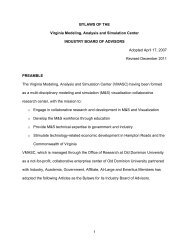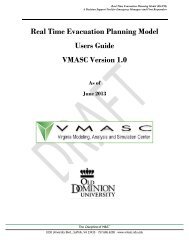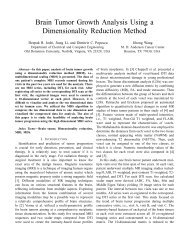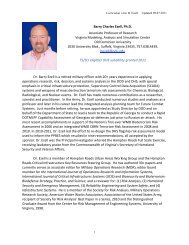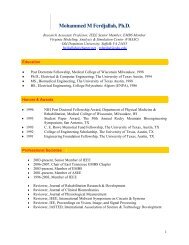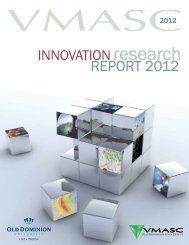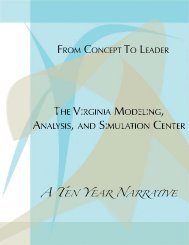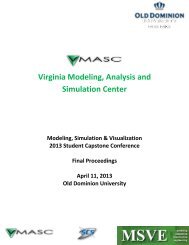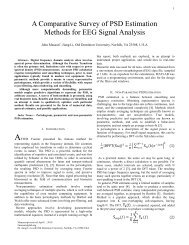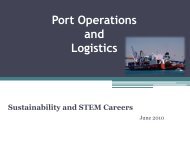2009 Student Capstone Proceedings - the Virginia Modeling ...
2009 Student Capstone Proceedings - the Virginia Modeling ...
2009 Student Capstone Proceedings - the Virginia Modeling ...
You also want an ePaper? Increase the reach of your titles
YUMPU automatically turns print PDFs into web optimized ePapers that Google loves.
proceedings<br />
<strong>2009</strong><br />
STUDENT CAPSTONE CONFERENCE<br />
April 9, <strong>2009</strong><br />
<strong>Virginia</strong> <strong>Modeling</strong>, Analysis and<br />
Simulation Center<br />
Suffolk, <strong>Virginia</strong>
<strong>2009</strong>
Edited by<br />
Ca<strong>the</strong>rine M. Banks &<br />
Kaleen J. Lawsure<br />
©<strong>2009</strong> ODU-VMASC MS&G<br />
<strong>Student</strong> <strong>Capstone</strong> Conference<br />
Responsibility for <strong>the</strong> accuracy of all<br />
statements in each paper rests solely<br />
with <strong>the</strong> author(s). Statements are<br />
not necessarily representative of, nor<br />
endorsed by <strong>the</strong> <strong>Virginia</strong> <strong>Modeling</strong>,<br />
Analysis, and Simulation Center (VMASC).<br />
Permission is granted to photocopy<br />
portions of this proceeding for student<br />
use providing <strong>the</strong> source is cited giving<br />
credit to <strong>the</strong> <strong>2009</strong> VMASC MS&G<br />
<strong>Student</strong> <strong>Capstone</strong> Conference. Permission<br />
is not granted to any o<strong>the</strong>r type of<br />
reproduction.<br />
The <strong>Virginia</strong> <strong>Modeling</strong>, Analysis,<br />
and Simulation Center<br />
1030 University Boulevard<br />
Suffolk, <strong>Virginia</strong> 23435<br />
STUDENT CAPSTONE CONFERENCE
Invited Keynote Speakers<br />
Dr. Gabriel Wainer<br />
Carleton University,<br />
Ottawa, Canada<br />
Dr. R. Bowen Loftin<br />
Texas A&M,<br />
Galveston, Texas<br />
Conference General Chairpersons<br />
Dr. Ca<strong>the</strong>rine Banks, VMASC<br />
Kaleen Lawsure, VMASC<br />
CREATIVITY is thinking up new things.<br />
INNOVATION is doing new things.<br />
~ Theodore Levitt<br />
Primary Sponsor<br />
The <strong>Virginia</strong> <strong>Modeling</strong>, Analysis,<br />
and Simulation Center<br />
http://www.vmasc.odu.edu/<br />
capstoneconference
Contents<br />
Overview .. . . . . . . . . . . . . . . . . . . . . . 1<br />
KEYNOTE SPEAKERS . . . . . . . . . . . . . . . . . 2<br />
Conference Tracks . . . . . . . . . . . . . . . . . . 4<br />
TRACK LEADERS & JUDGES . . . . . . . . . . . . . 5<br />
<strong>2009</strong> <strong>Student</strong> <strong>Capstone</strong> Conference Winners . . . . 7<br />
CONFERENCE PROCEEDINGS . . . . . . . . . . . . 8<br />
Conference Attendees . . . . . . . . . . . . . . . 16<br />
SPONSORS . . . . . . . . . . . . . . . . . . . . 19<br />
<strong>Modeling</strong>, Simulation & Gaming • <strong>Student</strong> <strong>Capstone</strong> Conference <strong>2009</strong><br />
The <strong>Virginia</strong> <strong>Modeling</strong>, Analysis, and Simulation Center is pleased to provide <strong>the</strong> conference proceeding<br />
for <strong>the</strong> <strong>2009</strong> <strong>Modeling</strong>, Simulation & Gaming (MS&G) <strong>Student</strong> <strong>Capstone</strong> Conference.<br />
This annual conference featured students from universities and colleges across <strong>the</strong> country. The student<br />
research and projects submitted to <strong>the</strong> conference are central to MS&G. It is here that students are given a<br />
venue to present <strong>the</strong>ir findings to members of <strong>the</strong> modeling and simulation community in academe, industry,<br />
and government. For many of our students <strong>the</strong>se presentations serve as a culmination of <strong>the</strong>ir research and<br />
academic careers.<br />
The <strong>2009</strong> conference facilitated six tracks and each track was assigned judges who voted for <strong>the</strong> first,<br />
second, and third outstanding project of that particular track. These students were recognized at <strong>the</strong><br />
<strong>Capstone</strong> Banquet <strong>the</strong> evening of April 9th.<br />
Also participating in <strong>the</strong> conference were faculty who have volunteered <strong>the</strong>ir time to impart direct support<br />
to <strong>the</strong>ir students’ research by facilitating <strong>the</strong> various conference tracks, serving as referees for papers,<br />
serving as judges for each of <strong>the</strong> tracks, and providing overall assistance to this conference.
keynote speakers<br />
Dr. Gabriel Wainer<br />
Gabriel Wainer, SMSCS, SMIEEE, received <strong>the</strong> M.Sc. (1993) and Ph.D. degrees (1998, with<br />
highest honors) of <strong>the</strong> University of Buenos Aires (Argentina), and Université Paul Cézanne<br />
(Aix-Marseille III, France).<br />
Discovery consists of<br />
seeing what everybody<br />
has seen and thinking<br />
what nobody has<br />
thought.<br />
Albert von<br />
Szent-Gyorgy<br />
In July 2000, he joined <strong>the</strong> Department of Systems and Computer Engineering, Carleton University<br />
(Ottawa, ON, Canada), where he is now an Associate Professor. He has held positions<br />
at <strong>the</strong> Computer Science Department of <strong>the</strong> University of Buenos Aires, and visiting positions<br />
in numerous places, including <strong>the</strong> University of Arizona (USA), Ecole Polytéchnique de Marseille,<br />
LSIS-CNRS, University of Nice and INRIA Sophia-Antipolis (France). He is author of a<br />
book on Real-Time systems, three o<strong>the</strong>rs on Discrete-Event Simulation and over 190 research<br />
articles. He has collaborated in <strong>the</strong> organization of over 80 conferences in <strong>the</strong> area.<br />
He was Principal Investigator of different research projects (funded by <strong>the</strong> National Science<br />
and Engineering Research Council of Canada, Precarn, Usenix, <strong>the</strong> Canadian Foundation of<br />
Innovation, CANARIE, and private companies including Hewlett-Packard, IBM, Intel and MDA<br />
Corporation). He has been <strong>the</strong> recipient of various awards (including <strong>the</strong> IBM Eclipse Innovation<br />
Award, a Leadership award by <strong>the</strong> Society for <strong>Modeling</strong> and Simulation International<br />
–SCS- and a Best Paper award in an international contest organized by CICC, Japan).<br />
He is a member of <strong>the</strong> Real-Time and Distributed systems lab at Carleton University, a chair<br />
of Carleton University’s University’s Research Centre in Technology Innovation and <strong>the</strong> head<br />
of <strong>the</strong> Advanced Real-Time Simulation lab within Carleton University Centre for advanced<br />
Simulation and Visualization (V-Sim).<br />
He is Special Issues Editor of <strong>the</strong> Transactions of <strong>the</strong> SCS, and Associate Editor of <strong>the</strong> International<br />
Journal of Simulation and Process <strong>Modeling</strong> and <strong>the</strong> Journal of Defense <strong>Modeling</strong><br />
and Simulation. He was a member of <strong>the</strong> Board of Directors of <strong>the</strong> SCS, and a chairman of<br />
<strong>the</strong> DEVS standardization study group (SISO). He is Director of <strong>the</strong> Ottawa Center of The<br />
McLeod Institute of Simulation Sciences and chair of <strong>the</strong> Ottawa M&SNet.<br />
His current research interests are related with modelling methodologies and tools, parallel/<br />
distributed simulation and real-time systems.<br />
CAPSTONE <strong>2009</strong>
Dr. Bowen Loftin<br />
R. Bowen Loftin holds a B.S. in physics from Texas A&M University (1970) and an M.A. and a Ph.D. in physics<br />
from Rice University (1973, 1975). Since May, 2005 Bowen has been Vice President and Chief Executive<br />
Officer of Texas A&M University’s branch campus in Galveston, Texas where he is also Professor of Maritime<br />
Systems Engineering. He also holds a joint appointment as Professor of Industrial and Systems Engineering at<br />
Texas A&M University (College Station, Texas). From 2000 to 2005 he was at Old Dominion University in Norfolk,<br />
<strong>Virginia</strong> as Professor of Electrical and Computer Engineering and Professor of Computer Science.<br />
In addition, Bowen was Old Dominion University’s Director of Simulation Programs with responsibility for <strong>the</strong><br />
university’s graduate programs in modeling and simulation and Executive Director of <strong>the</strong> <strong>Virginia</strong> <strong>Modeling</strong>,<br />
Analysis and Simulation Center. Before coming to Old Dominion University, he was Professor in and Chair of<br />
<strong>the</strong> Department of Computer Science and Director of <strong>the</strong> NASA Virtual Environments Research Institute at <strong>the</strong><br />
University of Houston. For over twenty years, Dr. Loftin has been teaching and conducting research in modeling<br />
and simulation.<br />
Learning and<br />
innovation go<br />
hand in hand.<br />
The arrogance of<br />
success is to think<br />
that what you<br />
did yesterday will<br />
be sufficient for<br />
tomorrow.<br />
William Pollard<br />
The applications of his research have been in domains as diverse as scientific/engineering data visualization<br />
and analysis; astronaut training; hydrocarbon exploration; and defense training, analysis, and mission planning.<br />
He is a frequent consultant to both industry and government.<br />
Dr. Loftin serves on advisory committees and panels sponsored by numerous government and professional<br />
organizations. His awards include <strong>the</strong> University of Houston-Downtown Awards for Excellence in Teaching and<br />
in Service (twice), <strong>the</strong> American Association of Artificial Intelligence Award for an Innovative Application of Artificial<br />
Intelligence, NASA’s Space Act Award, <strong>the</strong> NASA Public Service Medal, <strong>the</strong> NASA Invention of <strong>the</strong> Year<br />
Award, and <strong>the</strong> IEEE Virtual Reality Conference Career Award.<br />
He is <strong>the</strong> author or co-author of more than one hundred technical publications.<br />
CAPSTONE <strong>2009</strong>
Conference Tracks<br />
Body of Knowledge/Applied Principles of M&S<br />
The Body of Knowledge is <strong>the</strong> domain of knowledge and capability that serves to provide identity<br />
to <strong>the</strong> profession of specific discipline. This track focuses on <strong>the</strong> BoK of M&S, which means<br />
presentations should address core elements of <strong>the</strong> discipline of modeling and simulation. It<br />
covers fundamental concept areas (such as <strong>the</strong>ory of simulation, principles of distributed simulation,<br />
composability and interoperability, verification and validation) and application domains such<br />
as representation techniques, in particular behavior representation in M&S, integration into <strong>the</strong><br />
application infrastructure, enabling emerging technologies.<br />
General Science<br />
This track encompasses <strong>the</strong> use of modeling and simulation in <strong>the</strong> non-medical sciences and is open<br />
to all science disciplines. Examples include, but are not limited to, ecology, evolution, paleontology,<br />
climate modeling, oceanography, biochemistry and behavior. Any application of modeling and<br />
simulation in <strong>the</strong> life sciences is a candidate for this track.<br />
Homeland Security/Military<br />
This track encompasses modeling and simulation that has been applied in ei<strong>the</strong>r <strong>the</strong> military or<br />
homeland security domain. It will also include any work done in <strong>the</strong>se domains that interfaces M&S<br />
capabilities with command and control systems and M&S work to support operations research,<br />
analysis, and visualization of military or homeland security systems or problems.<br />
Medical<br />
This track looks into various aspects of medical modeling and simulation from imaging capability<br />
to <strong>the</strong> augmented standardized patient (using augmented virtual reality). <strong>Modeling</strong> of physical<br />
systems, such as joints and muscles, <strong>the</strong> virtual operating room, and virtual reality for rehabilitation<br />
are also key to this application area. The development of simulators and <strong>the</strong> validation of those<br />
simulators will also be covered in this track.<br />
M&S in Engineering<br />
This track focuses on M&S methodologies and applications in <strong>the</strong> broader domain of engineering.<br />
One aspect is that simulation more and more replaces <strong>the</strong> traditional experimentation and<br />
prototyping. The track looks for such M&S ideas and examples and necessary changes in <strong>the</strong>se<br />
traditional disciplines. Examples are, but are not limited to, enterprise decision support, optimization,<br />
product design, testing, life cycle support, and more.<br />
Transportation<br />
This track includes applications of modeling and simulation to solving multimodal transportation<br />
problems. The development, validation, and application of microscopic and macroscopic traffic<br />
simulation, travel demand models, and hardware in <strong>the</strong> loop simulation are appropriate research<br />
topics for surface (road) transportation. Simulations of port facilities, railroads, and <strong>the</strong> air<br />
transportation system are also included in this track.
There’s a way to do it better - find it.<br />
Thomas Edison<br />
Track Leaders & Judges<br />
Body of Knowledge/Applied Principles of M&S<br />
Track Leader: Dr. Andreas Tolk, VMASC/ODU College of Engineering and Technology<br />
Judges: Dr. Evelyn Brown, East Carolina State and<br />
Dr. Peter Kemper, College of William and Mary<br />
General Science<br />
Track Leader: Dr. Poornima Madhavan, VMASC/ODU College of Science<br />
Judges: Dr. James Comstock, NASA-Langley Research Center and<br />
Ms. Hea<strong>the</strong>r Miller, Lockheed Martin<br />
Homeland Security/Military<br />
Track Leader: Dr. John Sokolowski, Director of Research – VMASC<br />
Judges: Mr. Greg Knapp, JFCOM and<br />
Dr. Mike Bailey, Marine Corps, OAD<br />
Medical<br />
Track Leader: Dr. Gianluca DeLeo, VMASC/ODU College of Health Sciences<br />
Judges: Mr. Brent Smith, Engineering & Computer Simulations, Orlando, FL and<br />
Dr. Donald Combs, Eastern <strong>Virginia</strong> Medical Center<br />
M&S in Engineering<br />
Track Leader: Dr. Rafael Diaz, VMASC<br />
Judges: Mr. Jeff Laskowski, Lockheed Martin and<br />
Dr. Young-Jun Son, University of Arizona<br />
Transportation<br />
Track Leader: Mr. Mike Robinson, VMASC<br />
Judges: Mr. Bill Cashman, URS Corps., Mr. Bob Kuhns, Clark Nexsen and<br />
Mr. Paul Agnello, <strong>Virginia</strong> Department of Transportation<br />
CAPSTONE <strong>2009</strong>
The Gene Newman Award<br />
for Excellence in M&S Research<br />
The Gene Newman Award for Excellence in M&S Research<br />
was established in recognition of Mr. Eugene G. Newman<br />
for his tireless effort in advancing modeling and simulation<br />
education, research, and development. Mr. Newman played<br />
a significant role in <strong>the</strong> creation of VMASC (in 1997) by<br />
realizing <strong>the</strong> need for credentialed experts in <strong>the</strong> M&S workforce in <strong>the</strong> military<br />
and in industry. His foresight has affected both <strong>the</strong> economic development and<br />
<strong>the</strong> high level of expertise in <strong>the</strong> M&S community of Hampton Roads. <strong>Student</strong>s<br />
receiving this first place award have proven <strong>the</strong>mselves to be outstanding<br />
researchers and practitioners of modeling and simulation.<br />
CAPSTONE <strong>2009</strong>
<strong>Student</strong> Winners<br />
Transportation<br />
1st<br />
2nd<br />
3rd<br />
Peter Foytik, Old Dominion University<br />
Yufei Shen, Joel Hanssen, Old Dominion University<br />
Hongbing Zhang, Old Dominion University<br />
Medical<br />
1st Emin Kugu, Old Dominion University<br />
2nd<br />
3rd<br />
T. Robert Turner, Old Dominion University<br />
Wenjuan Jiang, Old Dominion University<br />
Homeland Security/Military<br />
1st<br />
2nd<br />
3rd<br />
Cadets Jared Helle, Nate Lauer, Jeff Gamez, Matt Dedmon, U.S. Military Academy<br />
Alexandra B. Proaps, Old Dominion University<br />
Brent D. Morrow, Old Dominion University<br />
M&S in Engineering<br />
1st<br />
2nd<br />
3rd<br />
Jie Wang, Ozhan Unal, Old Dominion University<br />
Saikou Diallo, James Muguira, Old Dominion University<br />
Philip Cho, Ben Lozano, Kevin O’Neill, Jered Smith, U.S. Air Force Academy<br />
Body of Knowledge/Applied Principles of M&S<br />
1st<br />
2nd<br />
3rd<br />
Charles Turnitsa, Old Dominion University<br />
Ross Gore, University of <strong>Virginia</strong><br />
James Muguira, Old Dominion University<br />
General Science<br />
1st Justin F. Brunelle, Old Dominion University<br />
2nd Ruth Lamprecht, William & Mary<br />
3rd Felix Portnoy, Old Dominion University<br />
One person with passion is better<br />
than forty people merely interested.<br />
E. M. Forster<br />
CAPSTONE <strong>2009</strong>
Body of Knowledge &<br />
Applied Principles of M&S<br />
A Taxonomy of Interoperability Challenges<br />
James Muguira<br />
Abstract: Interoperability is an active area of <strong>Modeling</strong> and<br />
Simulation that focuses on connecting systems and components<br />
toge<strong>the</strong>r in order to achieve a goal that a single system<br />
or component cannot o<strong>the</strong>rwise achieve. The benefits of<br />
interoperability include reduction in development time, cost savings<br />
and <strong>the</strong> promotion of reuse. However, interoperability is not a<br />
monolithic function and many taxonomies of interoperability have<br />
been developed to classify <strong>the</strong> levels at which systems interoperate.<br />
As a result, <strong>the</strong>re is a better understanding of interoperability and<br />
<strong>the</strong> steps required to achieve a certain level of interoperability.<br />
While <strong>the</strong>se taxonomies are important and useful, <strong>the</strong>re are a series<br />
of recurrent issues that arise during <strong>the</strong> actual coupling of systems<br />
and components. Many of those issues have been identified in <strong>the</strong><br />
literature and in general some very clever, but ad-hoc, methods for<br />
resolving <strong>the</strong>m are documented. This dissertation derives a method<br />
to classify <strong>the</strong>se various challenging situations in a taxonomy<br />
and proposes a method to extend it for <strong>the</strong> future. The proposed<br />
taxonomy offers a classification of issues in interoperability, and<br />
shows how it can be used early in <strong>the</strong> federation development<br />
cycle to predict, mitigate and account for problems that typically<br />
are dealt with later on in <strong>the</strong> development and/or test cycle. The<br />
proposed taxonomy can also be used as a prescriptive guide for<br />
developing interoperable systems and components.<br />
Knowledge Representation for <strong>Modeling</strong> and<br />
Simulation<br />
Charles Turnitsa<br />
Abstract: The exchange of data between different models is<br />
about <strong>the</strong> exchange of information from within <strong>the</strong> context of two<br />
separate worldviews. This amounts to knowledge (information<br />
in context). To represent this knowledge, in any of a number of<br />
different ways (meta-data, ontological reference, frames, etc.) <strong>the</strong>re<br />
must be a method to bridge <strong>the</strong> gap between what <strong>the</strong> worldview<br />
of origination can represent and what <strong>the</strong> worldview of destination<br />
can receive. As each separate model is <strong>the</strong> product of a different<br />
perspective by <strong>the</strong> model’s developer, each individual model will<br />
have a different worldview. Identifying this world view is crucial<br />
towards identifying both <strong>the</strong> knowledge representation capabilities<br />
and requirements that exist in model composability efforts.<br />
The Impact of Standards on Interoperability:<br />
A Case Study Using <strong>the</strong> JC3IEDM<br />
Saikou Diallo, James Muguira<br />
Abstract: The emergence of interoperability standards and<br />
standardization bodies such as <strong>the</strong> Simulation Interoperability<br />
Standards Organization (SISO) should facilitate <strong>the</strong> creation<br />
and reuse of an interoperable solution. However, as simulation<br />
practitioners use existing standards, new challenges have emerged.<br />
Issues such as standards implementation, use and reuse of standard<br />
solutions, applicability of standards to particular problems and<br />
adaptability of reference implementations, have yet to be<br />
discussed in depth within <strong>the</strong> <strong>Modeling</strong> and Simulation community.<br />
Such discussions based on lessons learned would be very beneficial<br />
to a standards developer as <strong>the</strong>y provide valuable feedback<br />
and a glimpse into <strong>the</strong> future. This paper will examine <strong>the</strong> Joint<br />
Command, Control and Consultation Information Exchange Data<br />
Model (JC3IEDM) which has been recommended as <strong>the</strong> data model<br />
of choice for <strong>the</strong> Coalition-Battle Management Language (C-BML)<br />
group. Originally developed and maintained by <strong>the</strong> Multilateral<br />
Interoperability Programme (MIP), it has been successfully applied<br />
to different projects linking C2 and M&S systems. Some of <strong>the</strong><br />
lessons learned from <strong>the</strong>se applications point to <strong>the</strong> fact that<br />
while systems were using a common logical model, implementation<br />
decisions greatly affected <strong>the</strong> technical interoperability between<br />
systems, sometimes leading to a complete redesign of solutions. In<br />
this paper, we apply a formal engineering method, Model Based<br />
Data Engineering (MBDE) to a use case involving <strong>the</strong> JC3IEDM to<br />
capture and describe <strong>the</strong> variance in solutions using a common<br />
standard. The paper will first describe <strong>the</strong> projects involved,<br />
apply MBDE to derive composites, generate a common language<br />
based on <strong>the</strong> standard, and compare each solution to <strong>the</strong> common<br />
language thus derived. The paper will finally categorize <strong>the</strong><br />
variances and make recommendations on <strong>the</strong> way forward.<br />
A Survey of Current Applications of Agent Based<br />
Models in Combat <strong>Modeling</strong><br />
Brent Morrow<br />
Abstract: Agent-based models have many applications throughout<br />
combat modeling. This paper looks at agent-based models,<br />
discusses some characteristics of <strong>the</strong> models, and briefly describes<br />
some of <strong>the</strong> current applications of agent-based models in <strong>the</strong> field<br />
of combat modeling.<br />
<strong>Modeling</strong> and Simulation in <strong>the</strong> Procurement Process:<br />
An Update on PEO Soldier<br />
Anil Ustun, Saikou Diallo<br />
Abstract: <strong>Modeling</strong> and Simulation (M&S) is significantly changing<br />
<strong>the</strong> military technical decision making. Military forces and many<br />
leading companies already use some aspects of M&S applications<br />
and a wide-array of simulation models for <strong>the</strong>ir purposes. The<br />
latest requirement of <strong>the</strong> U.S. Army’s Program Executive Office<br />
(PEO) is to acquire a new type of body armor (BA) for <strong>the</strong> entire<br />
force. Traditional acquisition process will cost billions of dollars<br />
to determine which type of BA will be <strong>the</strong> most cost efficient and<br />
beneficial to <strong>the</strong> Force. The PEO Soldier program was instituted<br />
to evaluate <strong>the</strong> use of M&S to support <strong>the</strong> procurement process<br />
and to provide a more cost efficient way to solve complex R&D<br />
problems. A review of existing simulations showed that <strong>the</strong>re is<br />
no single model that fully represents <strong>the</strong> acquisition process, thus<br />
<strong>the</strong> need for a federated approach. In <strong>the</strong> initial phase of <strong>the</strong><br />
program an integrated solution using <strong>the</strong> High Level Architecture<br />
(HLA) and existing simulations showed how M&S can be used in<br />
<strong>the</strong> acquisition of BA. The resulting architecture was documented<br />
using <strong>the</strong> Model Driven Architecture (MDA). This paper describes<br />
<strong>the</strong> follow on efforts to introduce a common initialization process,<br />
C O N F E R E N C E p r o c e e d i n g s<br />
CAPSTONE <strong>2009</strong>
provide Situational Awareness (SA) and a Common Operational<br />
Picture (COP) and align <strong>the</strong> Command and Control (C2) data in<br />
<strong>the</strong> Federation Object Model (FOM) with <strong>the</strong> Joint Consultation,<br />
Command, and Control Information Exchange Data Model<br />
(JC3IEDM).<br />
Program Slice Distribution Functions<br />
Ross Gore<br />
Abstract: Unexpected behaviors in simulations require explanation,<br />
so that decision makers and subject matter experts can separate<br />
valid behaviors from design or coding errors. Validation of<br />
unexpected behaviors requires accumulation of insight into <strong>the</strong><br />
behavior and <strong>the</strong> conditions under which it arises. Stochastic<br />
simulations are known for unexpected behaviors that can be difficult<br />
to recreate and explain. To facilitate exploration, analysis and<br />
understanding of unexpected behaviors in stochastic simulations I<br />
have developed a novel approach called, Program Slice Distribution<br />
Functions (PSDFs), for quantifying <strong>the</strong> uncertainty of <strong>the</strong> dynamic<br />
program slices (simulation executions) causing unexpected behaviors.<br />
My use of PSDFs is <strong>the</strong> first approach to quantifying <strong>the</strong> uncertainty<br />
in program slices for stochastic simulations and extends <strong>the</strong> state of<br />
<strong>the</strong> art in analysis and informed decision making based on simulation<br />
outcomes. I apply PSDFs to a published epidemic simulation<br />
and describe how users can apply PSDFs to <strong>the</strong>ir own stochastic<br />
simulations.<br />
General Science<br />
<strong>Modeling</strong> Calcium Signaling Complexes in Mobius<br />
Ruth Lamprecht, Gregory D. Smith, Peter Kemper<br />
Abstract: Ma<strong>the</strong>matical models of calcium (Ca^2+) signaling<br />
complexes can take <strong>the</strong> form of compositionally defined Markov<br />
chains constructed from single channel models of intracellular Ca^2+<br />
channels. Using <strong>the</strong> De~Young-Keizer inositol (1,4,5)-trisphosphate<br />
receptor/Ca^2+ channel (IP3R) model as modified by Shuai and<br />
coworkers, we illustrate how Stochastic Activity Networks (SANs)<br />
with state-sharing composition operations can be used to model<br />
intracellular Ca^2+-regulated Ca^2+ channels through <strong>the</strong><br />
specification and replication of channel subunits. We reproduce<br />
<strong>the</strong> single channel behavior investigated by Shuai et al. and<br />
explore <strong>the</strong> parameter sensitivity of <strong>the</strong> model. The SAN formalism<br />
is subsequently used to study <strong>the</strong> behavior of Ca^2+ signaling<br />
complexes composed of multiple stochastically gating De~Young-<br />
Keizer IP3Rs coupled to one ano<strong>the</strong>r through a common local Ca^2+<br />
concentration.<br />
Using Persistence Display to Increase Change<br />
Detection in Graphical Gauges in a Simulated Process<br />
Control Room Environment<br />
Felix Portnoy, Poornima Madhavan<br />
uniquely designed for this study. The persistence display<br />
was test under different magnitudes of changes in graphical<br />
gauges and was compared to traditional displays that are<br />
prevalent in <strong>the</strong> process control industry. The results of this<br />
study show that persistence display increased <strong>the</strong> users’ visual<br />
sensitivity such that <strong>the</strong>ir ability to detect changes in graphical<br />
gauges was greater compared to traditional forms of display<br />
across all levels in magnitude change. Fur<strong>the</strong>r recommendations<br />
are made to continue evaluating <strong>the</strong> effect that persistence<br />
display may have on operators training.<br />
Validating a Social Science Theory Using Agentbased<br />
Approach<br />
Georges M. Arnaout, Shannon Bowling<br />
Abstract: Agent-based modeling is a powerful tool that offers<br />
efficient ways to study controversial and unproven <strong>the</strong>ories in<br />
most areas of science, specifically social science. One <strong>the</strong>ory<br />
that we have is <strong>the</strong> following: “It has been previously claimed<br />
that men having short hair gives <strong>the</strong>m a competitive advantage<br />
over men with long hair, at least in hand to hand combat. As<br />
societies evolved, <strong>the</strong> competitive advantage was nullified<br />
because conflicts became rarer”. The example used here<br />
demonstrates <strong>the</strong> <strong>the</strong>ory that men’s hair length is influenced<br />
by factors in society, one of which is conflict rate. We propose<br />
that <strong>the</strong> small competitive advantage created by having short<br />
hair over time yields to a complete adoption of <strong>the</strong> society<br />
to desire that behavior. Not only is <strong>the</strong> behavior adopted,<br />
but is also becomes part of <strong>the</strong> moral standards of a society.<br />
However, once <strong>the</strong> forcing function is removed (conflict rate) <strong>the</strong><br />
once dominate behavior begins to wane and societies begin<br />
changing behavior or reverting back to less dominant behavior<br />
once again. The main objective of <strong>the</strong> paper is to introduce<br />
how agent-based models can be constructed in order to prove<br />
<strong>the</strong>ories, or at least give insights in different areas of science<br />
such as social science. The use of computer social simulation<br />
for building our model is introduced in order to validate <strong>the</strong><br />
proposed <strong>the</strong>ory. Keywords: Agent-based modeling, combat<br />
modeling, simulated experiment, computer social simulation<br />
Virtual Reality Training for IAEA Inspectors<br />
Kimberly Gilligan<br />
Abstract: The International Atomic Energy Agency (IAEA)<br />
could greatly benefit from <strong>the</strong> utilization of a virtual reality<br />
training system. Inspectors perform a unique function in <strong>the</strong><br />
nonproliferation regime and need to have an excellent<br />
command of many different skills. Virtual reality training would<br />
help to ameliorate challenges faced by <strong>the</strong> IAEA inspectors<br />
that are inherent in <strong>the</strong> organization. This paper serves as an<br />
overview of <strong>the</strong>se challenges and <strong>the</strong> benefits of virtual reality<br />
training for <strong>the</strong> IAEA. The paper <strong>the</strong>n proposes a description of<br />
a possible training system.<br />
Abstract: This study investigates <strong>the</strong> effect of a novel form for<br />
display mechanism, named “persistence display”, on visual sensitivity<br />
to changes in graphical gauges. The effectiveness of <strong>the</strong> persistence<br />
display was evaluated in a simulated process control environment,<br />
CAPSTONE <strong>2009</strong>
Integrating Problem-Based Learning and Simulation<br />
Enilda J. Romero, Dr. Ginger S. Watson<br />
Abstract: Problem-based learning (PBL) and simulations are<br />
instructional strategies that helped transition <strong>the</strong> traditional<br />
classroom environment, in which <strong>the</strong> learner does not have a<br />
participatory role, to a more prolific and engaging setting where<br />
learners have active roles. When combined, <strong>the</strong>se two instructional<br />
strategies provide an array of benefits. Specifically, <strong>the</strong> learner is<br />
provided focus in <strong>the</strong> inquiry learning process coupled with more<br />
guided instruction presented by <strong>the</strong> simulation. The simulation<br />
presents <strong>the</strong> learner with boundaries that help center <strong>the</strong> focus on<br />
<strong>the</strong> curriculum goals stated by <strong>the</strong> instructor. In order to successfully<br />
integrate problem-based learning and simulation it is essential<br />
to have an understanding of <strong>the</strong> <strong>the</strong>oretical foundations of both<br />
problem-based learning and simulation, most specifically <strong>the</strong><br />
classification of problems and <strong>the</strong> different types of simulations.<br />
Choosing <strong>the</strong> correct type of problem for a specific simulation<br />
type will prove to be beneficial for both <strong>the</strong> instructor and <strong>the</strong><br />
learner. This paper provides a summarized <strong>the</strong>oretical foundation<br />
of problem-based learning and simulation. Because of its recent<br />
implementation, simulations for problem-based learning are<br />
considered a new instructional strategy. There are many inherent<br />
issues that need to be considered when planning to use PBL<br />
simulation. In this paper, we refer to <strong>the</strong> PBL simulation model of<br />
Maxwell et al. and address some of <strong>the</strong> inherent issues instructors<br />
will face when using PBL simulation. The paper ends with future<br />
research considerations and concerns.<br />
MiBoard: Metacognitive Training Through Gaming in<br />
iSTART<br />
Justin F. Brunelle, Irwin B. Levinstein, and Chutima Boonthum<br />
Abstract: MiBoard (Multiplayer Interactive Board Game) is an<br />
online, turn-based board game, which is a supplement of <strong>the</strong><br />
iSTART (Interactive Strategy Training for Active Reading and<br />
Thinking) application. MiBoard is developed to test <strong>the</strong> hypo<strong>the</strong>sis<br />
that integrating game characteristics (point rewards, gamelike<br />
interaction, and peer feedback) into <strong>the</strong> iSTART trainer will<br />
significantly improve its effectiveness on students’ learning. It was<br />
shown by M. Rowe that a physical board game did in fact enhance<br />
students’ performance. MiBoard is a computer-based version of<br />
Rowe’s board game that eliminates constraints on locality while<br />
retaining <strong>the</strong> crucial practice components that were <strong>the</strong> game’s<br />
objective. MiBoard gives incentives for participation and provides<br />
a more enjoyable and social practice environment compared to <strong>the</strong><br />
online individual practice component of <strong>the</strong> original trainer.<br />
An Empirical Comparison of Spatial versus Verbal<br />
Distractions on Human-automation Integrated<br />
Performance<br />
Rachel Phillips, Poornima Madhavan<br />
Abstract: Using a luggage screening (visual) primary task, we<br />
examined <strong>the</strong> impact of including a cross-modal (auditory)<br />
distractor task in a competing or non-competing processing code<br />
(spatial versus verbal) on performance. For half of <strong>the</strong> participants,<br />
we also examined <strong>the</strong> influence of including a distractor task on<br />
interaction with a 70% reliable automated decision aid. The design<br />
was a 2 (aid: aided vs. unaided) x 2 (processing code: spatial vs.<br />
verbal) x 2 (distraction: distracted vs. undistracted) mixed design<br />
with aid and processing code as between subjects factors, and<br />
distraction as <strong>the</strong> within. Participants were measured for workload,<br />
system trust (in <strong>the</strong> aided condition), compliance and reliance, as<br />
well as hit and false alarm rates. Findings revealed a higher false<br />
alarm rate in <strong>the</strong> aided versus unaided condition and, unexpectedly,<br />
a lower false alarm rate in <strong>the</strong> distracted versus undistracted<br />
condition. Participant compliance levels (<strong>the</strong> probability of agreeing<br />
with <strong>the</strong> automation when it said “weapon present”) were influenced<br />
not only by <strong>the</strong> presence or absence of a distractor but also by <strong>the</strong><br />
distractor processing code. Compliance increased with <strong>the</strong> addition<br />
of a spatial distractor but decreased with <strong>the</strong> addition of <strong>the</strong> verbal<br />
distractor. System calibration, as measured by trust, was moderately<br />
affected by distractor processing code, such that those in <strong>the</strong> verbal<br />
condition demonstrated more accurate calibration than those<br />
in <strong>the</strong> spatial. These findings contribute to <strong>the</strong> understanding of<br />
influences on human-automation integrated performance and have<br />
implications for both multiple system and environmental design.<br />
Homeland Security/Military<br />
Emergent Leadership and Team Performance as a<br />
Function of Task Difficulty Using a Computer Game-<br />
Based Architecture<br />
Alexandra Proaps, Dr. James P. Bliss<br />
Abstract: Specialized military field training can be expensive,<br />
time-consuming and dangerous. The use of computer game based<br />
architectures may help provide a safe, controlled environment<br />
in which geographically dispersed military units (i.e., distributed<br />
teams) can develop decision-making and leadership skills<br />
while rehearsing a specific task, such as building clearing, area<br />
reconnaissance, or navigation. Leaders of distributed teams need<br />
to know how to perform to overcome <strong>the</strong> challenges involved in<br />
<strong>the</strong>se virtual environment contexts. Current research shows some<br />
implications of task difficulty for how distributed team members<br />
emerge as leaders within a virtual environment. The purpose of <strong>the</strong><br />
proposed study is to investigate <strong>the</strong> influence of task difficulty on<br />
emergent leadership and team task performance during a team<br />
navigation task using a modified version of <strong>the</strong> popular video<br />
game, Half Life 2 . The experimenters will determine how an<br />
individual emerges as a leader during a navigation task, whe<strong>the</strong>r<br />
task difficulty will decrease <strong>the</strong> speed, level of accuracy and level<br />
of efficiency with which <strong>the</strong> task is completed and whe<strong>the</strong>r task<br />
difficulty will influence how a leader emerges during <strong>the</strong> task.<br />
A Roadmap for Conditions Based Maintenance for<br />
Small Arms<br />
Cadets Kelvin Espinal, Michael Griffin, Mat<strong>the</strong>w Hanes, Stephan<br />
McCarthy<br />
Abstract: The current small arms maintenance system in <strong>the</strong> U.S.<br />
Army repairs weapons after <strong>the</strong>y fail and are rendered non-mission<br />
capable. The study proposes a Condition Based Maintenance (CBM)<br />
C O N F E R E N C E p r o c e e d i n g s<br />
CAPSTONE <strong>2009</strong><br />
10
oadmap for small arms utilizing preemptive measures to monitor,<br />
track, and assess <strong>the</strong> condition of <strong>the</strong> Army’s small arms weapons<br />
arsenal. At <strong>the</strong> request of Program Manager (PM) Soldier Weapons<br />
in Picatinny Arsenal, NJ, <strong>the</strong> goal of <strong>the</strong> study is to increase <strong>the</strong><br />
reliability of small arms by reducing unscheduled maintenance;<br />
thus, simultaneously increasing scheduled maintenance and soldiers’<br />
confidence levels. The M249 Squad Automatic Weapon (SAW), <strong>the</strong><br />
Army’s primary man-portable machine gun, is used as <strong>the</strong> test bed<br />
weapon system for <strong>the</strong> purposes of this study. The desired outcome<br />
is a streamlined Army maintenance system synchronizing <strong>the</strong> current<br />
reactive maintenance system with <strong>the</strong> preferred preventative<br />
maintenance system. Using West Point’s Department of Systems<br />
Engineering System Decision Process (SDP), <strong>the</strong> study makes use<br />
of several techniques to include stakeholder analysis, functional<br />
analysis, value modeling, and computer simulation. Stakeholder<br />
buy-in, involvement, feedback, and research are imperative in<br />
determining <strong>the</strong> preferred system. These methods lead to both a<br />
quantitative and qualitative solutions which allow for comparison<br />
between <strong>the</strong> current and proposed system. Statistical and sensitivity<br />
analysis of <strong>the</strong> simulation and model output as well as stakeholder<br />
feedback drive <strong>the</strong> final solution and recommendation. The final<br />
recommendation includes considerations required for implementing<br />
and maintaining <strong>the</strong> proposed system over its entire life cycle. The<br />
solution will require Army-wide doctrinal and procedural changes.<br />
Combined Simulation Program for Defense Strategies<br />
Cadets Megan Ennenga, Joshua Kassel, Adam Moore, Courtney<br />
Wright<br />
Abstract: Concerted efforts to adapt to an unconventional enemy<br />
in <strong>the</strong> United States’ ongoing military campaign are imperative to<br />
future successes. Our military capabilities, weapon systems, and<br />
installations in <strong>the</strong> current fight are constantly exposed to new<br />
and creative enemy threats. Our project relies on past research<br />
by former cadets and is in support of <strong>the</strong> Armament Research,<br />
Development and Engineering Center at Picatinny Arsenal. The goal<br />
of our project is to accurately simulate unmanned aerial vehicle<br />
(UAV) attacks on a company sized forward operating base (FOB)<br />
in Iraq in hopes of assessing both <strong>the</strong> offensive capabilities of <strong>the</strong><br />
enemy, as well as <strong>the</strong> defensive plans of friendly forces to counter<br />
those attacks. Fur<strong>the</strong>r, our research syn<strong>the</strong>sizes several computer<br />
technologies in order to effectively simulate <strong>the</strong> uncertainties but<br />
real possibilities of <strong>the</strong> future battlefield. To methodically approach<br />
this project, we are applying <strong>the</strong> Systems Decision Process (SDP),<br />
a process developed by <strong>the</strong> Department of Systems Engineering<br />
(DSE), United States Military Academy at West Point, NY. Using<br />
stakeholder analysis and research we developed ideas for<br />
different types of attacks and defenses, along with <strong>the</strong> necessary<br />
functionality for a simulation. A number of different simulation<br />
capabilities are combined in a federated simulation model to<br />
analyze our different alternatives, ultimately leading us to a<br />
recommendation concerning <strong>the</strong> developing aerial threat in today’s<br />
fight.<br />
A Surge in Afghanistan – <strong>Modeling</strong> a Focused<br />
Security Effort<br />
Brent Morrow<br />
Abstract: This paper discusses a proposed <strong>the</strong>sis that investigates<br />
<strong>the</strong> insurgency in Afghanistan. The author proposes using agentbased<br />
modeling to construct a model and run a simulation that<br />
tries to determine if a troop surge emphasizing a Focused Security<br />
Effort can be successful in defeating <strong>the</strong> Neo-Taliban insurgency in<br />
Afghanistan.<br />
Force Structure of <strong>the</strong> Shadow Platoon<br />
Cadets Justin McCarty, Adrienne Rolle, Dan Szatkowski, Ty Volkman<br />
Abstract: The Shadow is an unmanned aerial vehicle operated<br />
as a system by a platoon that provides real time battlefield<br />
reconnaissance, surveillance, intelligence and situational awareness.<br />
Experience has proven that as <strong>the</strong> dependence on unmanned<br />
systems grows, <strong>the</strong> ability of <strong>the</strong> team of operators and maintainers<br />
to keep pace with combat requirements is severely stressed. A<br />
serious result of this reality are mishaps that result in partial or<br />
complete loss of a vehicle, which handicaps <strong>the</strong> ability of <strong>the</strong> system<br />
to meet <strong>the</strong> needs of <strong>the</strong> command and limits <strong>the</strong> exploitation of<br />
<strong>the</strong> technology across domains and functions. However, mishaps<br />
can be prevented, particularly those caused by human error ei<strong>the</strong>r<br />
by <strong>the</strong> operator or <strong>the</strong> maintainer. In <strong>the</strong> high intensity environment<br />
of extended combat operations, human error – including fatigue,<br />
work overload, and procedural shortcuts – must be managed in<br />
order to prevent mishaps and bring <strong>the</strong> rate of incidents in line with<br />
manned aviation. If <strong>the</strong> organizational structure does not support<br />
operational requirements, <strong>the</strong>n <strong>the</strong> stress of continuous operations<br />
above <strong>the</strong> programmed capability will cause a breakdown in <strong>the</strong><br />
form of mishaps. An increase in mishaps can directly impact mission<br />
accomplishment, or <strong>the</strong> slow degradation of <strong>the</strong> performance and<br />
morale of <strong>the</strong> platoon’s personnel. The purpose of this research is<br />
to recommend changes to <strong>the</strong> current force structure of <strong>the</strong> Shadow<br />
platoon. Alternative force structures are developed and evaluated<br />
using <strong>the</strong> Systems Decision Process and several modeling techniques,<br />
including discrete event simulation.<br />
Leveraging Reliability Growth for System O&S Life<br />
Cycle Cost Estimating<br />
Jared Helle, Nate Lauer, Jeff Gamez, Matt Dedmon<br />
Abstract: We propose a new methodology for leveraging<br />
reliability growth models to link time-dependent test and evaluation<br />
reliability measures to independent life cycle cost estimates for<br />
operating and sustainment costs supporting major DoD systems<br />
acquisition projects. Integrating both deterministic and Monte Carlo<br />
methods, we demonstrate <strong>the</strong> effectiveness of this approach on <strong>the</strong><br />
Block 1 UH-60M Blackhawk helicopter currently in first unit equip<br />
(FUE), comparing <strong>the</strong> results with current LCCE procedures.<br />
11 CAPSTONE <strong>2009</strong>
Causal Loop Diagram for <strong>the</strong> Analysis of US State<br />
Department Funding for <strong>the</strong> Democratic Republic of<br />
<strong>the</strong> Congo<br />
Bill Crane<br />
Abstract: This paper provides a review of <strong>the</strong> funding at <strong>the</strong> United<br />
States Department of State for <strong>the</strong> Democratic Republic of <strong>the</strong><br />
Congo (DRC). It uses a causal loop diagram to determine key nodes<br />
in <strong>the</strong> DRC that must be address to help reduce <strong>the</strong> insurgency and<br />
thus help with <strong>the</strong> stability of <strong>the</strong> country. Based on <strong>the</strong>se key nodes<br />
and <strong>the</strong> funding, a conclusion will be made as to whe<strong>the</strong>r <strong>the</strong> money<br />
is being spent in a manner that supports <strong>the</strong> critical nodes in <strong>the</strong><br />
model.<br />
GroundWars 2: Developing a Small Unit Combat<br />
Simulation<br />
Menion Croll<br />
Abstract: This paper describes <strong>the</strong> GroundWars 2 model, a small<br />
unit combat simulation developed using open source tools, intended<br />
for <strong>the</strong> evaluation of future combat systems. Traditional simulations<br />
use probability of hit, P_h, and probability of kill, P_k, tables to<br />
determine weapon effectiveness. GroundWars 2 uses trajectory<br />
analysis based on weapon characteristics and configurable<br />
damage regions, instead of P_h and P_k, to determine engagement<br />
outcomes. Monte Carlo simulation is used to compile <strong>the</strong> results, with<br />
<strong>the</strong> added capability of real-time playback of individual simulation<br />
runs for more in depth analysis.<br />
Medical<br />
Single Muscle Fiber Action Potentials <strong>Modeling</strong> and<br />
Simulations<br />
GyuTae Kim, Mohammed Ferdjallah<br />
Abstract: The objective of this paper is to use modeling and<br />
simulation concepts to design an electrophysiological single muscle<br />
fiber model to investigate <strong>the</strong> effects of fiber size, electrode<br />
location, and volume conduction properties on muscle action<br />
potentials and electromyographic signals measured ei<strong>the</strong>r through<br />
invasive or noninvasive electrodes. The long term goal of this model<br />
is to design an entire muscle model to access muscle fatigue, ageing<br />
process, zero-gravity (space area), and disease effects (obesity,<br />
CP) on <strong>the</strong> anatomy and physiology of <strong>the</strong> muscle.<br />
Three Models in Improving Communication among<br />
Children with Autism<br />
Padmaja L. Battagiri<br />
Abstract: Autism is one of <strong>the</strong> most common neurodevelopmental<br />
disorders observed in children impairing <strong>the</strong>ir interactive and<br />
communication skills. Picture Exchange Communication System<br />
(PECS), based on <strong>the</strong> simple principle of exchanging pictures<br />
for conveying messages, is proven to be a powerful tool for<br />
communication. PECS being paper-based demands caregivers to<br />
draw, print and laminate pictures required which is time-consuming.<br />
In order to overcome this difficulty, <strong>the</strong>re are electronic devices<br />
designed and available in <strong>the</strong> market which requires basic skills for<br />
operation, making <strong>the</strong>m futile for younger group of children with<br />
severe autism. Therefore, a device which is more suitable for target<br />
users is desired. It can be designed according to user-centered<br />
model involving actual users in <strong>the</strong> testing process. Since, <strong>the</strong> actual<br />
users of this process are children, and <strong>the</strong>ir involvement in <strong>the</strong><br />
testing is not acceptable, simulation of <strong>the</strong> users can be done. The<br />
teachers involved in training children with autism can be potential<br />
proxy users, since <strong>the</strong>y are in direct contact with children, and can<br />
easily identify <strong>the</strong> needs and preferences of <strong>the</strong> children. Thus, <strong>the</strong><br />
resultant software interventioning system, called PixTalk, has <strong>the</strong><br />
operation principle similar to PECS and simulating block similar<br />
to that in user-centered model. The system comprises of a Smartphone,<br />
used for browsing and selecting images, and a companion<br />
Website for managing children profiles and database of images,<br />
uploading customized images, choosing settings etc. Stored sessions<br />
in Smart-phone can also be uploaded onto website for analyzing<br />
usage of images to determine child’s progress.<br />
Evaluating Visual and Haptic Feedback on a Virtual<br />
Reality Simulator for Orthopedic Bone Pinning<br />
T. Robert Turner, Mark W. Scerbo, Dwight Meglan, and Robert<br />
Waddington<br />
Abstract: The Simulation-Based Open Surgery Training System<br />
(SOSTS) is a virtual reality simulator designed to provide training<br />
on a simulated orthopedic bone pinning procedure. The present<br />
version of SOSTS offers five distinct combinations of multi-sensory<br />
feedback during training: enhanced visuals/enhanced haptics,<br />
enhanced visuals/moderate haptics, enhanced visuals/no haptics,<br />
moderate visuals/enhanced haptics, and moderate visuals/<br />
moderate haptics. The purpose of this study was to investigate <strong>the</strong><br />
effects of visual and haptic feedback on participants’ ability to<br />
place a pin through a fractured tibia on <strong>the</strong> simulator. Enhanced<br />
visual feedback resulted in a significant reduction of pin alignment<br />
error, although participants in <strong>the</strong>se conditions took five times longer<br />
to achieve proficiency than those in <strong>the</strong> moderate visual feedback<br />
conditions. Any form of haptic feedback resulted in significantly<br />
greater pin placement error than no haptic feedback. The findings<br />
provide partial support for <strong>the</strong> proximity compatibility principle for<br />
display design.<br />
Prostate Cancer Biomarker Identification: A<br />
Comparative Study<br />
Wenjuan Jiang, Jiang Li and Rick McKenzie<br />
Abstract: With current development in proteomics, <strong>the</strong> discovery of<br />
potential biomarkers has been greatly improved and attracts more<br />
and more attentions. In this paper, we implement five classifiers<br />
(SVM, Bayesian Classifier, Decision Tree, Random Forest and MLP)<br />
to compare <strong>the</strong>ir performances for discriminating cancer spectra<br />
from normal ones in prostate cancer biomarker identification using<br />
MALDI-MS tissue imaging data. We apply <strong>the</strong> five classification<br />
algorithms on 974 spectra (947 normal, 27 cancer) collected at <strong>the</strong><br />
Eastern <strong>Virginia</strong> Medical School (EVMS) from one prostate tissue<br />
sample, and utilize a cross validation method and a bootstrap<br />
technique for <strong>the</strong> comparison. Experiment results show that <strong>the</strong><br />
Bayesian classifier performs better than <strong>the</strong> o<strong>the</strong>r four classifiers.<br />
C O N F E R E N C E p r o c e e d i n g s<br />
CAPSTONE <strong>2009</strong><br />
12
Assessment of Denoising Algorithms by Evolving <strong>the</strong><br />
Pareto Front<br />
Emin Kugu, Jiang Li<br />
Abstract: Many denoising algorithms exist for image enhancement.<br />
There is always a trade-off between denoising and feature<br />
preserving for different applications. Features in images, especially<br />
edges, can be lost during <strong>the</strong> denoising process. To avoid losing<br />
those features, several edge preserving denoising algorithms<br />
have been investigated. Most of <strong>the</strong> algorithms have one or more<br />
parameters. Different configurations of <strong>the</strong> parameters usually give<br />
different preferences to noise suppression or feature preservation.<br />
It is very difficult to access different algorithms consistently, partially<br />
due to <strong>the</strong> fact that <strong>the</strong> importance of noise removal and feature<br />
preservation is user and application dependent. Different users may<br />
have different preferences for <strong>the</strong> same application and <strong>the</strong> same<br />
user may have different preferences for different applications.<br />
In this paper, we use a multiobjective optimization algorithm, <strong>the</strong><br />
Strength Pareto Evolutionary Algorithm 2 (SPEA2), to optimize<br />
parameters for denoising algorithms, and to assess <strong>the</strong> algorithms<br />
in terms of <strong>the</strong> Pareto front produced by SPEA2. Pareto front is a<br />
curve in objective space, which corresponds to different parameter<br />
configurations with which <strong>the</strong> denoising algorithm can achieve all best<br />
possible objectives. We have defined three objectives for denoising<br />
algorithms: mean square error (MSE), entropy and second derivative<br />
of denoised images. We assessed four denoising algorithms:<br />
Gradient Anisotropic Diffusion Filter, Curvature Flow Filter, MinMax<br />
curvature flow filter and Directional Filter. Experiments show that<br />
<strong>the</strong> Pareto front is an effective tool for assessing different denoising<br />
algorithms.<br />
M&S in Engineering<br />
Allosource: Process Simulation and Analysis<br />
Philip Cho, Ben Lozano, Kevin O’Neill, Jered Smith<br />
Abstract: Allosource is a non-profit provider of bone, skin, and soft<br />
tissue allografts, including tendons, ligaments, and entire joints. As a<br />
result of rapid growth over <strong>the</strong> past several years, AlloSource needs<br />
to make <strong>the</strong>ir processes more efficient. Our goal is to provide an<br />
accurate and reliable SimProcess simulation tool that can be used<br />
for process analysis. In addition to constructing this simulation tool,<br />
our analysis team will look to discover specific choke points and<br />
resource utilization rates in order to make potential recommendations<br />
with regards to process configuration changes. After performing this<br />
initial analysis, our team will pursue different areas of sensitivity<br />
analysis. Our analysis team plans on examining how <strong>the</strong> inclusion of<br />
more rooms, processing tools, and employees improves throughput<br />
capabilities, overall processing time, and overall processing cost.<br />
Construction of this SimProcess model and <strong>the</strong> subsequent analysis will<br />
have an immediate impact on AlloSource, helping <strong>the</strong>m determine<br />
<strong>the</strong> most cost efficient process changes for <strong>the</strong> future, while also<br />
determining how to best deal with continuing operations growth.<br />
Suggestion of an MDA Framework to Support<br />
Simulation Based Projects<br />
Anil Ustun, Priyanka Kotikalpudi<br />
Abstract: The Model Driven Architecture (MDA) is an approach<br />
to IT systems development fostered by <strong>the</strong> Object Management<br />
Group (OMG) and often considered to be a milestone towards<br />
model-based development. Conceptual artifacts of MDA must not<br />
be seen only as input of generator tools but as <strong>the</strong> primary means<br />
of knowledge transfer and as <strong>the</strong> basis of <strong>the</strong> division of labor<br />
within a project. This ability can save money and time, and will<br />
result in better designs. An MDA framework is described with its<br />
conceptual artifacts and how it relates to M&S project lifecycles.<br />
The roles of team members of <strong>the</strong> simulation projects and <strong>the</strong> use<br />
of CIM, PIM and PSM are described in relation to <strong>the</strong> establishing<br />
of integration during <strong>the</strong> MDA development process. The paper<br />
is focusing on dynamic nature of M&S projects and suggests a<br />
framework regarding facilitating project management principles<br />
to heterogeneous simulation model projects.<br />
The Impact of Standards on Interoperability: A Case<br />
Study Using <strong>the</strong> JC3IEDM<br />
Saikou Diallo, James Muguira<br />
Abstract: The emergence of interoperability standards and<br />
standardization bodies such as <strong>the</strong> Simulation Interoperability<br />
Standards Organization (SISO) should facilitate <strong>the</strong> creation<br />
and reuse of an interoperable solution. However, as simulation<br />
practitioners use existing standards, new challenges have<br />
emerged. Issues such as standards implementation, use and reuse<br />
of standard solutions, applicability of standards to particular<br />
problems and adaptability of reference implementations, have<br />
yet to be discussed in depth within <strong>the</strong> <strong>Modeling</strong> and Simulation<br />
community. Such discussions based on lessons learned would<br />
be very beneficial to a standards developer as <strong>the</strong>y provide<br />
valuable feedback and a glimpse into <strong>the</strong> future. This paper will<br />
examine <strong>the</strong> Joint Command, Control and Consultation Information<br />
Exchange Data Model (JC3IEDM) which has been recommended<br />
as <strong>the</strong> data model of choice for <strong>the</strong> Coalition-Battle Management<br />
Language (C-BML) group. Originally developed and maintained<br />
by <strong>the</strong> Multilateral Interoperability Programme (MIP), it has been<br />
successfully applied to different projects linking C2 and M&S<br />
systems. Some of <strong>the</strong> lessons learned from <strong>the</strong>se applications<br />
point to <strong>the</strong> fact that while systems were using a common logical<br />
model, implementation decisions greatly affected <strong>the</strong> technical<br />
interoperability between systems, sometimes leading to a<br />
complete redesign of solutions. In this paper, we apply a formal<br />
engineering method, Model Based Data Engineering (MBDE) to<br />
a use case involving <strong>the</strong> JC3IEDM to capture and describe <strong>the</strong><br />
variance in solutions using a common standard. The paper will first<br />
describe <strong>the</strong> projects involved, apply MBDE to derive composites,<br />
generate a common language based on <strong>the</strong> standard, and<br />
compare each solution to <strong>the</strong> common language thus derived.<br />
The paper will finally categorize <strong>the</strong> variances and make<br />
recommendations on <strong>the</strong> way forward.<br />
13 CAPSTONE <strong>2009</strong>
Automatic High-Fidelity Roadway Generation<br />
Jie Wang, Ozhan Unal, Mecit Cetin, Yuzhong Shen, and Yiannis<br />
Papelis<br />
Abstract: Road is an essential feature for our lives. In this paper,<br />
a method is proposed to automatically generate <strong>the</strong> 3D road<br />
network geometry. This method minimizes manual labor required<br />
by past 3D road model generation process. It also incorporates civil<br />
engineering rules into account generating roads which can support<br />
civil engineering applications. Road specification, civil engineering<br />
rules, terrain information and surrounding environment are used as<br />
<strong>the</strong> inputs of this method and <strong>the</strong> output of this method is real time<br />
3D road network models. This method will greatly enhance <strong>the</strong> road<br />
modeling in many applications and abundant relevant technicians<br />
can take advantage of it.<br />
Butterfly Effect on Systems: <strong>Modeling</strong> and Analysis<br />
of Systems<br />
Baqer Alali, Abdullah Namankani, Fadi Ayoub, Federico Bermudez,<br />
and John Easter<br />
Abstract: Experimental methods and real life representations<br />
of complex systems are expensive, tedious or impossible. The<br />
purpose of this experiment is to explore complex chaotic systems,<br />
utilizing Netlogo to study <strong>the</strong> behavior of systems; specifically<br />
to investigate if small changes to elements or components of a<br />
system have dramatic changes to <strong>the</strong> whole system. By expanding<br />
on <strong>the</strong> “Gas in a Box” model within Netlogo we demonstrate how<br />
minor changes in <strong>the</strong> location of one particle will lead to dramatic<br />
changes in <strong>the</strong> overall system. To expand on <strong>the</strong> “Gas in a Box”<br />
model, a model was created with two sets of particle systems,<br />
conditionally independent from each o<strong>the</strong>r. We used <strong>the</strong> same<br />
systems’ seeds in order to have <strong>the</strong> two systems start from <strong>the</strong> same<br />
position. The coordinates of one particle in one of <strong>the</strong> systems was<br />
changed by adding 0.005 to <strong>the</strong> X and Y coordinates, to simulate<br />
a small change. After 200 simulations, <strong>the</strong> experiments indicate<br />
that in more complex systems, small changes affect <strong>the</strong> behavior<br />
of <strong>the</strong> system faster than in less complex systems. Once <strong>the</strong> change<br />
begins to propagate through <strong>the</strong> system, it propagates until a<br />
certain maximum separation among particles is regardless of <strong>the</strong><br />
complexity of <strong>the</strong> system.<br />
POTENTIAL READINESS AND ECONOMIC BENEFITS FROM<br />
INSTALLATION OF HEALTH AND USAGE MONITORING SYSTEM<br />
(HUMS) ON U.S. COAST GUARD HH-65C HELICOPTERS<br />
Kevin M. Wilson, Patrick T. Hester<br />
Abstract: Abstract—The objective of this study is to determine <strong>the</strong><br />
readiness and economical benefits of installing HUMS on <strong>the</strong> 102<br />
airframes composing <strong>the</strong> USCG HH-65C fleet through a deductive,<br />
quantitative survey by comparison of continued readiness and costs<br />
with and without HUMS. In particular, acquisition of a Health and<br />
Usage Monitoring System as a mitigation strategy for <strong>the</strong> reduction<br />
in service life limits and improved safety awareness on <strong>the</strong> H65C<br />
will be examined. Because HUMS has not been previously installed<br />
on <strong>the</strong> U.S. Coast Guard HH-65C helicopter, cost and readiness<br />
data from <strong>the</strong> U.S. Army HUMS initiatives will be used to predict<br />
HH-65C costs and benefit drivers.<br />
C O N F E R E N C E p r o c e e d i n g s<br />
Transportation<br />
What is <strong>the</strong> Role of Multiple Secondary Incidents in<br />
Traffic Operations<br />
Hongbing Zhang and Asad Khattak<br />
Abstract: Traffic incidents are a major source of uncertainty.<br />
Sometimes, a primary incident can result in multiple secondary<br />
incidents, which can be problematic. To identify roadways where<br />
multiple secondary incidents are more likely to occur and analyze<br />
primary and secondary incidents, an innovative analysis method<br />
based on a detailed incident dataset from Hampton Roads was<br />
developed. Incidents occurring on major freeways are categorized<br />
as 1) single incident, 2) one primary-secondary pair, and 3) one<br />
primary with two or more secondary incidents in <strong>the</strong> same and<br />
opposite directions. The last category captures large-scale events<br />
involving several secondary incidents. Ordinal regression models<br />
are estimated to quantify associations with key factors that include<br />
incident characteristics, roadway geometry and traffic flows.<br />
Fur<strong>the</strong>rmore, a deeper analysis of secondary incidents is conducted<br />
by examining <strong>the</strong> time gap between primary and secondary<br />
incidents. The time-gap is treated as conditional on <strong>the</strong> occurrence<br />
of secondary incidents and an appropriate statistical method, <strong>the</strong><br />
Heckman model, is used for estimation. This research contributes<br />
to incident management by characterizing and analyzing complex<br />
events involving multiple secondary incidents. The results support <strong>the</strong><br />
planning and operation of service patrols.<br />
Freight Trip Generation and Distribution Based on<br />
Global Insight Transearch Database<br />
Yufei Shen, Joel Hanssen, Yuzhong Shen, Roland Mielke, John<br />
Sokolowski, and Mike Robinson<br />
Abstract: In <strong>the</strong> absence of a Cargo freight model for Hampton<br />
Roads, <strong>the</strong> Transearch Database can be used to obtain truck trip<br />
estimates. The Global Insight Transearch Database describing<br />
current and projected freight movement in Hampton Roads was<br />
acquired from VDOT for use with this project. This paper presents<br />
<strong>the</strong> methods for freight trip generation and distribution based on<br />
<strong>the</strong> Global Insight Transearch database. This database was mined<br />
to produce estimates of truck traffic in 2000 and 2030. It provided<br />
<strong>the</strong> freight flow information in Hampton Roads for <strong>the</strong> subsequent<br />
process steps to assess <strong>the</strong> effects of freight on overall traffic flow<br />
of Hampton Roads in 2000 and 2030.<br />
OPTIMIZING PASSENGER FLOW THROUGH AIRPORT<br />
CHECKPOINTS USING DISCRETE EVENT SIMULATION<br />
Jeremy Brown, Poornima Madhavan<br />
Abstract: Abstract-The movement of passengers through an airport<br />
quickly, safely, and efficiently is <strong>the</strong> main function of <strong>the</strong> check-in<br />
counters and security checkpoints found in most airports. Humans<br />
are an integral part of this process; however, humans are prone<br />
to errors. These errors combined with o<strong>the</strong>r breakdowns in <strong>the</strong><br />
complex system of <strong>the</strong> airport can disrupt passenger flow through<br />
<strong>the</strong> airport leading to lengthy waiting times, missing luggage and<br />
missed flights. In this paper we present a model of passenger<br />
CAPSTONE <strong>2009</strong><br />
14
flow through an airport using discrete event simulation that will<br />
provide a closer look into <strong>the</strong> possible reasons for breakdowns<br />
and <strong>the</strong>ir implications for passenger flow. An important goal of this<br />
simulation is to present ways to optimize <strong>the</strong> work force to keep<br />
passenger flow smooth even during peak travel times and for<br />
emergency preparedness in case of adverse events.<br />
Passenger Car and SUV Crashes-Do <strong>the</strong> Human<br />
Factors Play a Vital Role<br />
Faisal Mahmud<br />
Abstract: In recent years, traffic safety has become a major<br />
concern for all of us regarding <strong>the</strong> increase of volume, mobility,<br />
speed and economy. From various types of research and studies, it<br />
has found that <strong>the</strong>re are several factors that directly or indirectly<br />
hamper <strong>the</strong> safety. The three major factors such as Vehicle factor,<br />
Environmental factor and Human factor provide important clues<br />
behind all categories of crashes causing fatality and property<br />
damage resulting in overall safety problem. In case of vehicle<br />
types, SUVs and Passenger Cars are more vulnerable because<br />
of <strong>the</strong>ir most use in <strong>the</strong> vicinity. In this research paper, Passenger<br />
Car and SUV crashes due to <strong>the</strong> specific unsafe driving acts<br />
(UDAs) or behavioral errors, considering <strong>the</strong> human factors, will<br />
be focused associated with <strong>the</strong> main reasons behind <strong>the</strong> crashes<br />
and thus resulting in injury severity. National Automotive Sampling<br />
System-Crashworthiness Data System (NASS CDS) is used to find<br />
out different cases that represented different types of crashes<br />
elaborately. One year’s worth of data is taken for sampling and<br />
analysis by using statistical software following weighted ordered<br />
logit model. Corresponding countermeasures are also discussed.<br />
Notional Model for Freight Forecasting<br />
Joel Hanssen<br />
Abstract: The commodity flow structure for modeling freight<br />
is rapidly gaining acceptance among transportation planning<br />
engineers. However, many aspects of <strong>the</strong> methodology are still in<br />
<strong>the</strong> development stage. My <strong>the</strong>sis work is <strong>the</strong> development of a<br />
notional model that illustrates <strong>the</strong> concept of <strong>the</strong> commodity flow<br />
structure. This paper discusses <strong>the</strong> progress achieved so far. This<br />
author is aware of only one software package that is capable of<br />
developing a model using this structure; Cube by Citilabs. Because<br />
transportation planning typically involves both freight vehicles<br />
and passenger vehicles, <strong>the</strong> model will be developed in two parts<br />
within <strong>the</strong> Cube environment. Part I of <strong>the</strong> Notional Model is <strong>the</strong><br />
well documented Travel Demand Model (or four-step model). This<br />
paper will provide a detailed look at a notional Travel Demand<br />
Model developed by utilizing programs in <strong>the</strong> Voyager module<br />
of <strong>the</strong> Cube software package. Part II will provide a step by<br />
step explanation of <strong>the</strong> commodity flow approach to freight<br />
modeling by briefly walking through <strong>the</strong> first five programs of<br />
<strong>the</strong> Cargo Module. The output matrices generated each step of<br />
<strong>the</strong> way by <strong>the</strong> notional Travel Demand Model and <strong>the</strong> notional<br />
Freight Demand Model could easily be presented in power point<br />
presentation or printed format. The Notional Model lays an<br />
excellent foundation for future research on this subject. Citilabs has<br />
expressed an interest in this model.<br />
Implementing a Mesoscopic Transportation<br />
Evacuation Model<br />
Peter Foytik<br />
Abstract: Large scale transportation planning for events such as<br />
evacuations have improved with <strong>the</strong> help of macroscopic planning<br />
tools, but sometimes more information is needed from <strong>the</strong> results<br />
of <strong>the</strong> simulation. Microscopic simulations provide <strong>the</strong> desired<br />
results, but require excessive time to run. Mesoscopic simulation,<br />
tools that are in between micro and macroscopic, can provide<br />
some of <strong>the</strong> behavioral aspects of <strong>the</strong> micro simulation and<br />
<strong>the</strong> processing time of <strong>the</strong> macro simulation resulting in a good<br />
solution for many transportation planners. This paper will describe<br />
<strong>the</strong> implementation of a hurricane evacuation transportation<br />
mesoscopic model within CitiLabs software Cube by creating<br />
custom scripts outside <strong>the</strong> capabilities of <strong>the</strong> default script<br />
generation, describe <strong>the</strong> strategy used to implement strategies<br />
inside Cube, as well as future developments with Cube.<br />
15 CAPSTONE <strong>2009</strong>
conference attendees<br />
STUDENTS<br />
Baqer Alali, Old Dominion University<br />
Mohammad Alzahrani, Old Dominion University<br />
Georges Arnaout, Old Dominion University<br />
Fadi Ayoub, Old Dominion University<br />
Padmaja Battagiri, Old Dominion University<br />
Sonya Bland-Williams, Old Dominion University<br />
Jeremy Brown, Old Dominion University<br />
Justin Brunelle, Old Dominion University<br />
Roberta Casnatgi, Old Dominion University<br />
Philip Cho, Air Force Academy<br />
Bill Crane, U.S. Army<br />
Menion Croll, Old Dominion University<br />
Latres Davis, Old Dominion University<br />
Mat<strong>the</strong>w Dedmon, West Point<br />
Saikou Diallo, Old Dominion University<br />
Joyce Downs, Old Dominion University<br />
Megan Ennenga, West Point<br />
Kelvin Espinal, West Point<br />
Peter Foytik, Old Dominion University<br />
Jeff Gamez, West Point<br />
Kimberly Gilligan, Old Dominion University<br />
Koren Goodman , Old Dominion University<br />
Ross Gore, University of <strong>Virginia</strong><br />
Mike Griffin, West Point<br />
Matt Hanes, West Point<br />
Joel Hanssen, Old Dominion University<br />
Jared Helle, West Point<br />
Wenjuan Jiang, Old Dominion University<br />
Josh Kassel, West Point<br />
Gyutae Kim, Old Dominion University<br />
Priyanka Kotikalpudi, Old Dominion University<br />
Emin Kugu, Old Dominion University<br />
Ruth Lamprecht, College of William & Mary<br />
Nathaniel Lauer, West Point<br />
Faisal Mahmud, Old Dominion University<br />
Steve McCarthy, West Point<br />
Adam Moore, West Point<br />
Brent Morrow, U.S. Army<br />
James Muguira, Old Dominion University<br />
Abdullah Namankani, Old Dominion University<br />
Kara Olson, Old Dominion University<br />
Kevin O’Neill, U.S. Air Force Academy<br />
Jose Padilla, Old Dominion University<br />
Rachel Phillips, Old Dominion University<br />
Felix Portnoy, Old Dominion University<br />
Alexandra Proaps, Old Dominion University<br />
Adrienna Rolle, West Point<br />
Enilda Romero, Old Dominion University<br />
Cassandra Rothrauft, Old Dominion University<br />
Mike Sovay, Old Dominion University<br />
Yufei Shen, Old Dominion University<br />
Dan Szatkowski, West Point<br />
Robert Turner, Old Dominion University<br />
Stacey Turner, Old Dominion University<br />
Charles Turnitsa, Old Dominion University<br />
Ozhan Unal, Old Dominion University<br />
Anil Ustun, Old Dominion University<br />
Ty Volkman, West Point<br />
CAPSTONE <strong>2009</strong><br />
16
Jie Wang, Old Dominion University<br />
Lydia Wigglesworth, Old Dominion University<br />
Kevin Wilson, Old Dominion University<br />
Courtney Wright, West Point<br />
Hongbing Zhang, Old Dominion University<br />
FACULTY<br />
Mike Bailey, U.S. Marine Corps/OAD<br />
Ca<strong>the</strong>rine Banks, Old Dominion University<br />
Evelyn Brown, East Carolina University<br />
Mecit Cetin, Old Dominion University<br />
Dean Chatfield, Old Dominion University<br />
Don Combs, Eastern <strong>Virginia</strong> Medical School<br />
Gianluca DeLeo, Old Dominion University<br />
Rafael Diaz, Old Dominion University<br />
Patrick Driscoll, INFORMS<br />
Holly Gaff, Old Dominion University<br />
Peter Kemper, College of William & Mary<br />
Kaleen Lawsure, Old Dominion University<br />
R. Bowen Loftin, Texas A & M<br />
Poornima Madhavan, Old Dominion University<br />
Daniel McCarthy, West Point<br />
Michael McGinnis, Old Dominion University<br />
Roland Mielke, Old Dominion University<br />
Yiannis Papelis, Old Dominion University<br />
Mike Robinson, Old Dominion University<br />
Huseyin Sarper, Colorado State University<br />
b<br />
John Sokolowski, Old Dominion University<br />
Young-Jun Son, University of Arizona<br />
Edward Teague, West Point<br />
Andres Tolk, Old Dominion University<br />
Prakash Viswanathan, Old Dominion University<br />
Gabriel Wainer, Carleton University<br />
Ginger Watson, Old Dominion University<br />
Donna Wilt, Hampton University<br />
GUESTS<br />
Paul Agnello, <strong>Virginia</strong> Department of Transportation<br />
Robert Armstrong, Booz Allen Hamilton<br />
David Bricker, U.S. Army<br />
Bill Cashman, URS Corp.<br />
John Carl, Booz Allen Hamilton<br />
James Comstock, NASA<br />
John Dannon, Lockheed Martin<br />
John Easter, Booz Allen Hamilton<br />
Mark Friedman, JFCOM<br />
Steve Hansen, Ray<strong>the</strong>on<br />
Greg Knapp, JFCOM<br />
Bob Kuhnz, Clark Nexsen<br />
Jeff Laskowski, Lockheed Martin<br />
Hea<strong>the</strong>r Miller, Lockheed Martin<br />
Frank Polste<br />
Brent Smith, Engineering & Computer Simulations<br />
17 CAPSTONE <strong>2009</strong>
conference<br />
Sponsors<br />
The <strong>2009</strong> MS&G <strong>Student</strong> <strong>Capstone</strong> Conference was sponsored by VMASC<br />
industry partners. Track sponsorship provided for <strong>the</strong> certificates, awards,<br />
and monetary gifts ($100, $50, $25) presented to <strong>the</strong> students.<br />
Special Thanks to:<br />
Sheila Flanagan<br />
Tracey Vann<br />
Karen Thompson<br />
David Ralph<br />
Richard Howell<br />
David Flanagan<br />
D’An Knowles<br />
Tara Ralph<br />
Cheryl Sparrer
Medical<br />
Sponsor: Eastern <strong>Virginia</strong> Medical School<br />
Homeland Security/Military<br />
Sponsor: Military Operations Research Society<br />
M&S in Engineering<br />
Sponsor: INFORMS<br />
Transportation<br />
Sponsor: SevaPort<br />
General Science<br />
Sponsor: Lockheed Martin<br />
Body of Knowledge/<br />
Applied Principles of M&S<br />
Sponsor: American Systems<br />
Office of Research<br />
Breakfast, Breaks, Lunch,<br />
Evening Reception, and<br />
Awards Banquet Food<br />
Sponsor: Old Dominion University<br />
Office of Research<br />
19 CAPSTONE <strong>2009</strong>
<strong>Virginia</strong> <strong>Modeling</strong>, Analysis and Simulation Center<br />
1031 University Boulevard | Suffolk, VA 23435 | 757.686.6200 | www.vmasc.odu.edu



